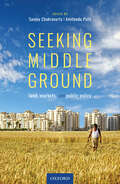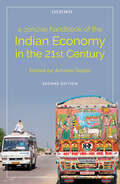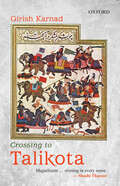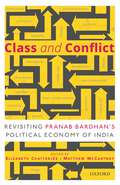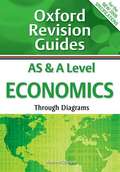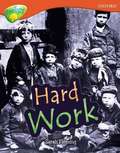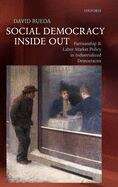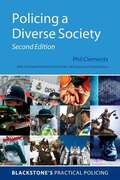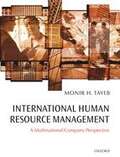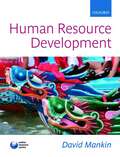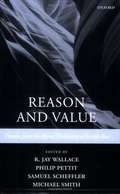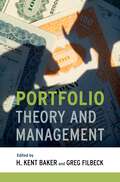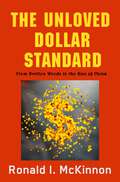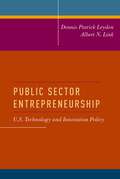- Table View
- List View
Indian Muslim(s) after Liberalization
by Maidul IslamClose to the turn of the century and almost 45 years after Independence, India opened its doors to free-market liberalization. Although meant as the promise to a better economic tomorrow, three decades later, many feel betrayed by the economic changes ushered in by this new financial era. Here is a book that probes whether India’s economic reforms have aided the development of Indian Muslims who have historically been denied the fruits of economic development. Maidul Islam points out that in current political discourse, the ‘Muslim question’ in India is not articulated in terms of demands for equity. Instead, the political leadership camouflages real issues of backwardness, prejudice, and social exclusion with the rhetoric of identity and security. Historically informed, empirically grounded, and with robust analytical rigour, the book tries to explore connections between multiple forms of Muslim marginalization, the socio-economic realities facing the community, and the formation of modern Muslim identity in the country. At a time when post-liberalization economic policies have created economic inequality and joblessness for significant sections of the population including Muslims, the book proposes working towards a radical democratic deepening in India.
Seeking Middle Ground: Land, Markets, and Public Policy
by Sanjoy Chakravorty Amitendu PalitLand is a subject of great conflict and debate in India. Over the last decade, it has influenced electoral verdicts and political fortunes and remains one of the most persistent challenges facing the nation. This book argues that the focus on politics and land acquisition has deflected attention from the possibilities of market-oriented approaches that are becoming relevant because of booming, but diverse, land markets. It aims to nudge the discussion towards a better understanding of the complementary strengths of state- and market-led approaches to the many problems of land in rural and urban India. Featuring original essays from leading analysts, this book examines the agrarian crisis and urbanization, laws and policies, displacement and compensation, factories and housing, cooperation and conflict, and other vital issues affecting land at the regional and national level. These multiple lines of enquiry make this book a critical and objective commentary on contemporary India and its ongoing economic, socio-political, and legal struggles with land.
A Concise Handbook of the Indian Economy in the 21st Century, Second Edition
by Ashima GoyalAfter a phase of slow growth post Independence, the Indian economy has experienced significant changes since the mid-1980s as a result of major reforms. India’s growth story has defied established economic patterns and, in the process, created interesting paradoxes that have attracted global attention. In this new edition of A Concise Handbook of the Indian Economy in the 21st Century, select chapters from the original have been updated to present a brief but comprehensive overview of the Indian economy, contributing to a finer understanding of India’s economic development. The volume adopts a non-ideological and forward-looking approach to discuss important economic issues. It takes into account various social and political factors impacting the Indian economy, and compares the importance of external market factors with that of domestic reforms in India’s economic growth. The book aims to provide a deep understanding of the economy based on careful fact-based research, which is a pre-requisite for formulating pragmatic reforms necessary to achieve sustained and inclusive growth.
Crossing to Talikota
by Girish KarnadThe year is 1565. Devastation reigns over the once-renowned Vijayanagara Empire. Its powerful army has buckled under the assault of four minor Sultanates. Within a few hours of the Battle of Talikota, the political contours of southern India have been radically altered, the rich and prosperous capital city, Vijayanagara, plundered, decimated, and abandoned. It would lie uninhabited for centuries, known thereafter only as ‘the ruins of Hampi’. Behind this cataclysm swirls a saga of ruthless ambition, caste, and religious conflict, family intrigue and betrayal, driven by the power hungry ‘Aliya’ Ramaraya, son-in-law of the emperor Krishna Deva Raya. A brilliant strategist and diplomat, he ruled the empire with an iron hand but was unacceptable to his own people as the legitimate heir because he lacked royal blood. In Crossing to Talikota, Girish Karnad focuses on the interplay of characters who have been ignored by history even though they played integral roles in shaping one of its darkest chapters.
Class and Conflict: Revisiting Pranab Bardhan’s Political Economy of India
by Elizabeth Chatterjee Matthew McCartneyIn 1984, Pranab Bardhan published his classic work The Political Economy of Development in India. It went on to become one of the most influential references on the political economy of development in the pre-reform period of independent India. Class and Conflict reflects on the enduring influence of Bardhan’s original publication in the context of post-liberalization developments in India. Drawing on their own world-leading research, the contributors to this volume engage with a wide range of issues, such as whether big business dominates India today, how subsidies retard economic growth, and how the middle classes are transforming politics. Together they try to answer the big question: what has really changed in the political and economic climate of the country over the last 30 years? Exploring the continuities and changes that have characterized India’s political economy since 1984, this volume takes stock of the main challenges of India’s economic development today. It contributes to current debates on economic growth, crony capitalism, agrarian crisis, the politics of class and caste, and the role of the state in a liberalizing economy.
Capitalisms: Towards a Global History
by Kaveh Yazdani Dilip M. MenonConventional accounts often conceive the genesis of capitalism in Europe within the conjunctures of agricultural, commercial, and industrial revolutions. Challenging this widely believed cliché, this volume traces the history of capitalism across civilizations, tenth century onwards, and argues that capitalism was neither a monolithic entity nor exclusively an economic phenomenon confined to the West. Looking at regions as diverse as England, South America, Russia, North Africa, and East, South, West, and Southeast Asia, the book explores the plurality of developments across time and space. The chapters analyse aspects such as historical conjunctures, commodity production and distribution, circulation of knowledge and personnel, and the role of mercantile capital, small producers, and force—all the while stressing the necessity to think beyond present-day national boundaries. The book argues that the multiple histories of capitalism can be better understood from a trans-regional, intercontinental, and interconnected perspective.
Economics For Cambridge IGCSE And O Level (PDF)
by Brian Titley Helen CarrierThe Oxford Revision Guides series builds on the fact that pictures are easier to memorise than words. Each topic is summarised on a single page using annotated diagrams and concise notes with a full index for easy reference. Students will save valuable revision time by using these notesinstead of condensing their own. In fact, many students are choosing to buy their own copies so they can colour code or highlight them as they might do their own revision notes.
Oxford Revision Guides: AS and A Level Economics Through Diagrams (3rd edition) (PDF)
by Andrew GillespieThe 'Oxford Revision Guides' series builds on the fact that pictures are easier to memorize than words. Each topic is summarized on a single page using annotated diagrams and concise notes with a full index for easy reference.
Oxford Reading Tree, Level 13, TreeTops Non-Fiction: Hard Work (PDF)
by Sarah FlemingBook band 13 grey. Oxford level 13. TreeTops Non-fiction offers fascinating titles in which children can access a wide range of interesting and thought-provoking topics. Supports the transition from learning to read, to reading to learnCovers a wide range of popular topics, fueling discussion. Great for combinating literacy with other subjects. Covers a range of non-fiction text types needed to expand your students' reading skills. Stunning photography and artwork engages readers and brings topics to life.
The Oxford Handbook Of Organizational Well-being
by Susan Cartwright Cary L. CooperIn today's changing business environment, the financial health of an organization is increasingly dependent on the extent to which it and its members are able to transform and adapt to these changing internal and external circumstances more effectively than their competitors. Health has been identified as a key driver of socio-economic progress internationally, emphasizing the link between the health of individual workers and the overall performance of an organization. Equally, decades of research has highlighted the major role that work plays in determining physical health and psychological well being. This handbook focuses on organizational well being in its widest sense, and is concerned with reviewing the factors which are associated with ill health, as well as those which promote positive health and well being. In it, leading international scholars focus on the key issues: * Absenteeism and presenteeism * Health and safety, * Models, measures, and methodologies for measuring well being, * Individual factors associated with well being such as leadership, emotion, stress, and risk and rewards, * Organizational factors associated with well being such as working hours, emotional labour, technology, and job insecurity, * Organizational strategies for improving individual well being. The handbook ends with two chapters setting out new perspectives - the link between well being and geography and climate, and the importance of corporate social responsibility in creating a sustainable and healthy work environment.
Social Democracy Inside Out: Partisanship And Labor Market Policy In Advanced Industrialized Democracies (PDF)
by David RuedaThe analysis in this book disputes entrenched interpretations of the comparative political economy of industrialized democracies. It questions, in particular, the widely-held assumption that social democratic governments will defend the interests of labor. The evidence shows that labor has become split into two clearly differentiated constituencies: those with secure employment (insiders) and those without (outsiders). The book focuses on three policy areas: employment protection (representing the main concern of insiders), and active and passive labor market policies (the main concern of outsiders). The main thrust of the argument is that the goals of social democratic parties are often best served by pursuing policies that benefit only insiders. The implication of the book's insider-outsider model is that social democratic government is associated with higher levels of employment protection legislation but not with labor market policy. The book also argues that there are factors can reduce insider-outsider differences and weaken their influence on social democratic governments. These hypotheses are explored through the triangulation of different methodologies. The book provides an analysis of surveys and macrodata, and a detailed comparison of three case-studies: Spain, the UK and the Netherlands. Its reinterpretation of the challenges facing social democracy will represent a significant contribution to the comparative politics and political economy literatures.
E-Business pdf (400 MB file request): A Management Perspective
by Jonathan ReynoldsThis text seeks to draw together a varied range of conceptual models and frameworks, existing empirical research, statistical and case study material to provide a coherent insight into e-business from a management perspective.
Public Finance And Public Choice: Analytical Perspectives (pdf)
by John Cullis Philip JonesPublic Finance and Public Choice provides a solid foundation in contemporary public economics, analysing different theoretical approaches and contextualising the theory with relevant and up-to-date examples. The authors have retained the focus on the public choice school of thought in this new edition and have also added an emphasis on behavioural public finance. The comprehensive nature of the analysis, coupled with the intuitive diagrammatic approach, ensures that students using this book gain a thorough understanding of the subject. Online Resource Centre The text will be accompanied by an Online Resource Centre which comprises For lecturers: Artwork from the book For students: Self-test questions (5 per chapter) Web links
Policing Domestic Violence (Blackstone's Practical Policing Ser.)
by Laura Richards Simon Letchford Sharon StrattonThis is a practical guide to policing domestic violence. It sets out approaches to help identify victims early and target offenders through the effective use of intelligence across a range of offending. It also offers guidance on investigative techniques, risk assessment, inter-agency murder reviews and information-sharing. The impact of domestic violence on children and other witnesses is discussed, and the powers available to police under new legislation are outlined. This title provides officers with information on all the practical measures to protect victims through the civil courts and through inter-agency schemes and perpetrator programmes. It also includes a chapter on the topical subject of honour-based violence and forced marriage and gives advice on the various measures officers can take. All the issues covered in the book are supplemented with useful case studies and checklists, as well as examples of log taking and relevant forms, illustrating how the issues are dealt with in practice. The book forms part of the Blackstone's Practical Policing Series. The series, aimed at junior to middle ranking officers, consists of practical guides containing clear and detailed explanations of the relevant legislation and practice, accompanied by case studies, illustrative diagrams and useful checklists.
Policing A Diverse Society (Blackstone's Practical Policing Ser. (PDF))
by Phil ClementsPolicing a Diverse Society, Second Edition is a one-stop, practical resource covering all the major issues associated with policing diversity in the Uk. Diversity issues affect every aspect of the police officer's role and are key to the successful training of police officers. While taking account of the theoretical perspectives on policing diversity, this text supports and encourages the development of the relevant practical skills required to respond to diversity effectively. This text takes into account the wide range of diversity issues that police officers will need to address in their work. The text has been completely revised to incorporate a number of important developments that have occurred since the first edition was written, such as: recent developments of the newly established combined body, the Commission for Equality and Human Rights; the July 7th Report; the Copenhagen cartoons and the Jean Charles de-Menezes investigation. The second edition also boasts an additional chapter dealing with the six diversity strands that form the focus of police training (race, gender, age, faith, sexuality and disability).
Principles Of Banking Law: (pdf)
by Sir Ross Cranston Emilios Avgouleas Kristin Van Zwieten Christopher Hare Theodor Van SanteThis book addresses the legal issues brought about by modern banking law. It sets out the legal rules within the context of modern banking practice and concentrates on principle rather than detail.
International Human Resource Management (PDF): A Multinational Company Perspective
by Monir H. TayebThis new textbook provides comprehensive coverage of the key issues facing multinational corporations (MNCs) in their management of human resources across diverse national boundaries. It attempts to answer the question, "Can there be a uniform set of best human resource management (HRM) practices applicable across a spectrum of nations irrespective of cultural and institutional individualities?" The book takes a broad definition of HRM and begins with a summary of key discussions and models in this area before setting them in the international context of the MNC. Adopting an integrated approach, the book covers the theories and practices of international HRM and sets them in context with numerous reference to news stories and case studies developed from the author's own extensive research. The book is student-focussed with strong learning features including learning objectives, chapter summaries, reading lists and an activities section in each chapter.
Understanding Psychological Contracts At Work: A Critical Evaluation Of Theory And Research (pdf)
by Neil Conway Rob B. BrinerHow can we understand the relationship between employer and employee? What determines the give and take of such relationships and what happens when they go wrong? This book is the first to provide a comprehensive and critical overview of what is now the major way of trying to understand the employment relationship - the concept of the psychological contract. Written contracts often specify very little in terms of the important details about what we are prepared to do for our employer and what we want back in return. The psychological contract considers these implicit or unwritten aspects of the employment relationship. What do employees really expect from work? What happens when the contract, or 'the deal', with their employer is broken? How well does the psychological contract help us understand what happens at work between an employee and their employer? Is the idea of practical value in managing employees? How can our understanding of this important concept be developed in the future? Starting with a history of the concept, from its emergence in the 1960s through to it finding wider acceptance in the 1990s, the authors trace the conflicting and changing definitions of the psychological contract. The shifting meaning of the concept allows possible methodological and conceptual weaknesses of the psychological contract to be explored, such as the conceptual emphasis on process within the employment relationship, which has so far been neglected by researchers. The authors start to address this issue by considering whether employees and employers can use what is known about the psychological contract to better manage the employment relationship. Written to provide a comprehensive yet critical introduction to the topic, Understanding Psychological Contracts at Work will be key reading for advanced students, lecturers, and researchers in Organizational Psychology, Organization Studies, Management Studies, Human Resource Management, Occupational Psychology; and professionals and practitioners in Occupational Psychology, Management Consultancy, Human Resource Management, Careers and Career Management, Career Counselling, Workplace Training.
Human Resource Development
by David MankinAssuming no prior knowledge or experience, this textbook provides an up to date introduction to the key concepts and issues within the field of learning and development. Blending key theories and concepts with a practical approach, the text covers the core areas that line managers and HRD practitioners need to know in order to design, implement and evaluate formal training interventions. In addition to these core areas, more contemporary issues such as learning and development within small and medium sized enterprises, and the sharing and management of knowledge are outlined. The textbook draws on a wide range of features to ensure and encourage learning and understanding. Within each chapter key concepts are introduced at the start of each chapter; other features include 'hints and tips' boxes, 'practitioner perspectives', and end of chapter case studies, and chapter revision questions. There is also a supporting online resource centre providing resources for students and lecturers.
Business Data Analysis Using Excel: (pdf)
by David WhighamTaking a thematic approach to the use of Excel spreadsheets in introductory business data analysis, this text has been designed to explain the overall nature of what is to be achieved and also instruction in how it is to be done. The learning approach is highly interactive and enables students to develop an understanding of the power of Excel in allowing both analysis of business data sets and in the flexible preparation of graphs, charts and tables for inclusion in reports and essays. The text is supported by an online resource center with self-marking exercises that can be used by instructors for formative and summative assessment, and a series of PowerPoint files containing all of the illustrated worksheets and figures.
Reason And Value (PDF): Themes From The Moral Philosophy Of Joseph Raz
by R. Jay Wallace Philip Pettit Samuel Scheffler Michael SmithReason and Value collects 15 new papers by leading contemporary philosophers on themes from the work of Joseph Raz. Raz has made major contributions in a wide range of areas, including jurisprudence, political philosophy, and the theory of practical reason; but all of his work displays a deep engagement with central themes in moral philosophy. The subtlety and power of Raz's reflections on ethical topics make his writings a fertile source for anyone working in this area. Especially significant are his explorations of the connections between practical reason and the theory of value, which constitute a sustained and penetrating treatment of a set of issues at the very center of moral philosophy as it is practiced today. The contributors to the volume acknowledge the importance of Raz's contributions by engaging critically with his positions and offering independent perspectives on the topics that he has addressed. The volume aims both to honour Raz's accomplishments in the area of ethical theorizing, and to contribute to an enhanced appreciation of the significance of his work for the subject.
Portfolio Theory and Management
by H. Kent Baker Greg FilbeckPortfolio management is an ongoing process of constructing portfolios that balances an investor's objectives with the portfolio manager's expectations about the future. This dynamic process provides the payoff for investors. Portfolio management evaluates individual assets or investments by their contribution to the risk and return of an investor's portfolio rather than in isolation. This is called the portfolio perspective. Thus, by constructing a diversified portfolio, a portfolio manager can reduce risk for a given level of expected return, compared to investing in an individual asset or security. According to modern portfolio theory (MPT), investors who do not follow a portfolio perspective bear risk that is not rewarded with greater expected return. Portfolio diversification works best when financial markets are operating normally compared to periods of market turmoil such as the 2007-2008 financial crisis. During periods of turmoil, correlations tend to increase thus reducing the benefits of diversification. Portfolio management today emerges as a dynamic process, which continues to evolve at a rapid pace. The purpose of Portfolio Theory and Management is to take readers from the foundations of portfolio management with the contributions of financial pioneers up to the latest trends emerging within the context of special topics. The book includes discussions of portfolio theory and management both before and after the 2007-2008 financial crisis. This volume provides a critical reflection of what worked and what did not work viewed from the perspective of the recent financial crisis. Further, the book is not restricted to the U.S. market but takes a more global focus by highlighting cross-country differences and practices. This 30-chapter book consists of seven sections. These chapters are: (1) portfolio theory and asset pricing, (2) the investment policy statement and fiduciary duties, (3) asset allocation and portfolio construction, (4) risk management, (V) portfolio execution, monitoring, and rebalancing, (6) evaluating and reporting portfolio performance, and (7) special topics.
Portfolio Theory and Management
by H. Kent Baker, Greg FilbeckPortfolio management is an ongoing process of constructing portfolios that balances an investor's objectives with the portfolio manager's expectations about the future. This dynamic process provides the payoff for investors. Portfolio management evaluates individual assets or investments by their contribution to the risk and return of an investor's portfolio rather than in isolation. This is called the portfolio perspective. Thus, by constructing a diversified portfolio, a portfolio manager can reduce risk for a given level of expected return, compared to investing in an individual asset or security. According to modern portfolio theory (MPT), investors who do not follow a portfolio perspective bear risk that is not rewarded with greater expected return. Portfolio diversification works best when financial markets are operating normally compared to periods of market turmoil such as the 2007-2008 financial crisis. During periods of turmoil, correlations tend to increase thus reducing the benefits of diversification. Portfolio management today emerges as a dynamic process, which continues to evolve at a rapid pace. The purpose of Portfolio Theory and Management is to take readers from the foundations of portfolio management with the contributions of financial pioneers up to the latest trends emerging within the context of special topics. The book includes discussions of portfolio theory and management both before and after the 2007-2008 financial crisis. This volume provides a critical reflection of what worked and what did not work viewed from the perspective of the recent financial crisis. Further, the book is not restricted to the U.S. market but takes a more global focus by highlighting cross-country differences and practices. This 30-chapter book consists of seven sections. These chapters are: (1) portfolio theory and asset pricing, (2) the investment policy statement and fiduciary duties, (3) asset allocation and portfolio construction, (4) risk management, (V) portfolio execution, monitoring, and rebalancing, (6) evaluating and reporting portfolio performance, and (7) special topics.
The Unloved Dollar Standard: From Bretton Woods to the Rise of China
by Ronald I. McKinnonThis book provides historical and analytical perspectives on the different phases of the postwar dollar standard in order to better understand its resilience in spite of the great volatility in today's global monetary system.
Public Sector Entrepreneurship: U.S. Technology and Innovation Policy
by Dennis Patrick Leyden Albert N. LinkPublic sector entrepreneurship refers to innovative public policy initiatives that generate greater economic prosperity. These initiatives can transform a status quo economic environment into one that is more conducive to economic units engaging in creative and innovative activities in the face of uncertainty. Public Sector Entrepreneurship traces the historical development of the concepts of private and public sector entrepreneurship and their connection to the separate notions of risk and uncertainty. Based on a formal conceptualization of these notions, the book illustrates throughout public sector entrepreneurship in practice using examples from U.S. technology and innovation policy. Technology policy-policy to enhance the application of new knowledge, learned through science, to some known problem-and innovation policy-policy to enhance the commercialization of a technology-are quintessential examples of the public sector recognizing and exploiting opportunities to bring about change and efficiency. Using this concept of public sector entrepreneurship as the lens to view the Bayh-Dole Act of 1980, the Stevenson-Wydler Act of 1980, the R&E Tax Credit of 1981, Small Business Innovation Development Act of 1982, the National Cooperative Research Act of 1984, and the Omnibus Trade and Competitiveness Act of 1988 affords us the ability to find elements of commonality among these policies and to discuss their impact on the U.S. economy from the perspective of entrepreneurial action.

